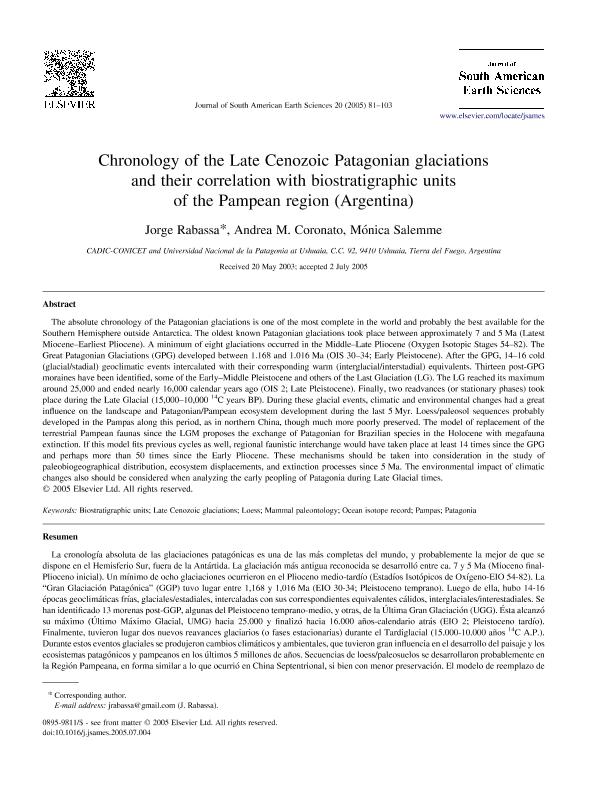Artículo
Chronology of the Late cenozoic Patagonian glaciations and their correlation with biostratigraphic units of the Pampean region (Argentina)
Fecha de publicación:
10/2005
Editorial:
Pergamon-Elsevier Science Ltd
Revista:
Journal of South American Earth Sciences
ISSN:
0895-9811
Idioma:
Inglés
Tipo de recurso:
Artículo publicado
Clasificación temática:
Resumen
Abstract Lava flows associated with Late Cenozoic glacial deposits and erratic boulders have been dated by several authors, who have identified a significant number of Patagonian glaciations. The absolute chronology of the Patagonian glaciations is one of the most complete in the world and probably the best available for the Southern Hemisphere outside Antarctica. The oldest known Patagonian glaciation took place between approximately 7 and 5 Ma (Latest Miocene–Earliest Pliocene). A minimum of eight glaciations occurred in the Middle–Late Pliocene (Oxygen Isotopic Stages 54–82). The Great Patagonian Glaciation (GPG) developed between 1.168 and 1.016 Ma (OIS 30–34; Early Pleistocene). After the GPG, 14–16 cold (glacial/stadial) geoclimatic events intercalated with their corresponding warm (interglacial/interstadial) equivalents. Thirteen post-GPG moraines have been identified, some of the Early–Middle Pleistocene and others of the Last Glaciation (LG). The LG reached its maximum around 25,000 and ended nearly 16,000 calendar years ago (OIS 2; Late Pleistocene). Finally, two readvances (or stationary phases) took place during the Late Glacial (15,000–10,000 14C years BP). During these glacial events, climatic and environmental changes had a great influence in the landscape and Patagonian/Pampean ecosystem development during the last 5 Myr. Loess/paleosol sequences probably developed in the Pampas along this period, as in northern China though much more poorly preserved. The model of replacement of the terrestrial Pampean faunas since the LGM proposes the exchange of Patagonian for Brazilian species in the Holocene with megafauna extinction. If this model fits previous cycles as well, regional faunistic interchange would have taken place at least 14 times since GPG and perhaps more than 50 times since the Early Pliocene. These mechanisms should be taken into consideration in the study of paleobiogeographical distribution, ecosystem displacements, and extinction processes since 5 Ma. The environmental impact of climatic changes also should be considered when analyzing the early peopling of Patagonia during Late Glacial times.
Archivos asociados
Licencia
Identificadores
Colecciones
Articulos(CADIC)
Articulos de CENTRO AUSTRAL DE INVESTIGACIONES CIENTIFICAS
Articulos de CENTRO AUSTRAL DE INVESTIGACIONES CIENTIFICAS
Citación
Rabassa, Jorge Oscar; Coronato, Andrea Maria Josefa; Salemme, Monica Cira; Chronology of the Late cenozoic Patagonian glaciations and their correlation with biostratigraphic units of the Pampean region (Argentina); Pergamon-Elsevier Science Ltd; Journal of South American Earth Sciences; 20; 1-2; 10-2005; 81-103
Compartir
Altmétricas




